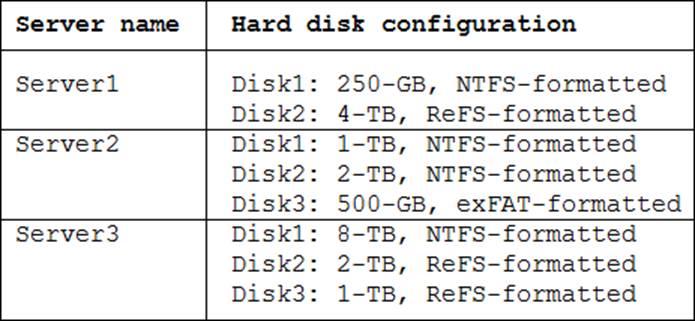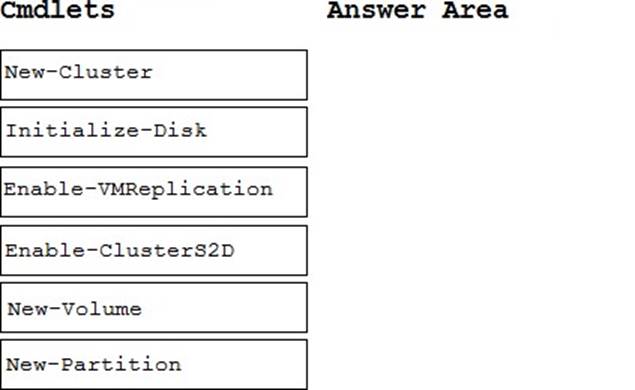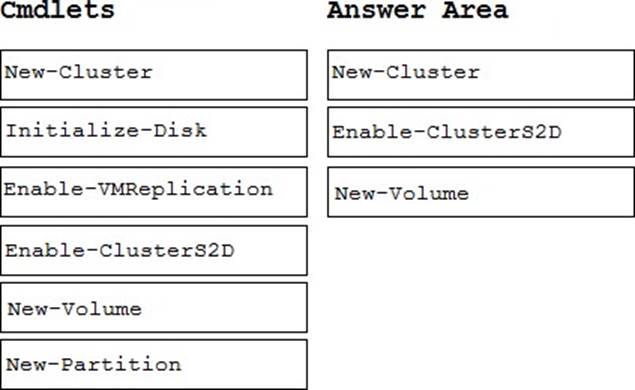Microsoft 70-740 Installation, Storage, and Compute with Windows Server 2016 Online Training
Microsoft 70-740 Online Training
The questions for 70-740 were last updated at Nov 04,2025.
- Exam Code: 70-740
- Exam Name: Installation, Storage, and Compute with Windows Server 2016
- Certification Provider: Microsoft
- Latest update: Nov 04,2025
Note: This question is part of a series of questions that present the same scenario. Each question in the series contains a unique solution that might meet the stated goals. Some question sets might have more than one correct solution, while others might not have a correct solution.
After you answer a question in this section, you will NOT be able to return to it. As a result, these questions will not appear in the review screen. You have two servers that run Windows Server 2016. You plan to create a Network Load Balancing (NLB) cluster that will contain both servers.
You need to configure the network cards on the servers for the planned NLB configuration.
Solution: You configure the network cards to be on a separate subnet and to have static IP addresses. You configure the cluster to use unicast.
Does this meet the goal?
- A . Yes
- B . No
You have two Hyper V hosts named Server1 and Server2 that run Windows Server 2012 R2. The servers are nodes in a failover cluster named Cluster1. You perform a rolling upgrade of the cluster nodes to Windows Server 2016. You need to ensure that you can implement the Virtual Machine Load Balancing feature.
Which cmdlet should you use?
- A . Update-ClusterNetWorkNameResource
- B . Set-GusterGroupSet
- C . Update-ClusterFunctionalLevel
- D . Set-CauClosterRole
You have a Windows Server 2016 failover Cluster named Cluster 1 that contains four nodes named Server1 Server2, Server3, and Serve4. You need to configure Cluster to use directly attached storage to store several virtual machines. You run the Enable-ClusterStorageSpacesDirect cmdlet on Server1.
What should you do next?
- A . Run the Enable-ClusterStorageSpacesDirect cmdlet on the other three nodes.
- B . Create volumes.
- C . Create storage pool.
- D . Add-ClustcrResource mdlet on all of the nodes.
You have a Hyper-V host named Server1 that runs Windows Server 2016. Server1 hosts a virtual machine named VM1 that runs Windows Server 2016.
On VM1, Dynamic Memory is disabled, MAC spoofing is enabled for the virtual network adapter, and checkpoints are disabled. You need to ensure that you can install the Hyper-V server role on VM1.
What should you do?
- A . Shut down VM1, enable Dynamic Memory on VM1 and then start VM1.
- B . Configure VM1 to use standard checkpoints.
- C . Disable Hyper-V integration services for VM1 and then restarts VM1.
- D . Shut down VMI, run the Set-VMProcessor cmdlet and then start VM1.
You have a server named Server1 that runs Windows Server 2016 and has the File and Storage Services server role installed. Server1 has an ReFS-formatted volume named Volume1 that is 512 GB. Volume1 is mounted as C:App1temp. You need to ensure that you can enable deduplication of Volume1.
What should you do?
- A . Initialize the physical disk that contains Volume1.
- B . Install a Windows feature.
- C . Format Volume1.
- D . Unmount Volume1.
You plan to deploy three servers that will run Windows Server 2016.
The servers will be configured as shown in the following table.

You need to ensure that you can use all of the available space on each disk.
What is one of the disks that you must initialize as a GPT disk?
- A . Disk2 on Server3
- B . Disk1 on Server2
- C . Disk3 on Server2
- D . Disk1 on Sever3
You have a server named Server 1 that runs Windows Server 2016 Window, Defender is enabled on Server1.
Server1 runs an application named App that stores various types of files in Microsoft OneDrive for Business, Microsoft OneDrive, and Microsoft SharePoint Online. Appt also Interacts with several local services,
You need to prevent Windows Defender from scanning any files opened by Appl.
Should you do on Server1?
- A . Run the Set-ExecutionPolicy cmdlet
- B . Form the Windows Defender settings, configure a file exclusion.
- C . From the Windows Defender settings, configure a process exclusion.
- D . Modify the cloud-based protection settings in Windows Defender.
You have a server named Server1 that runs Windows Server 2016. Windows Defender is enabled on Server1.
Server1 runs an application named App1 that stores various types of files in Microsoft OneDrive for Business, MicrosoftOneDrive, and Microsoft SharePoint Online. App1 also interacts with several local services.
You need to prevent Windows Defender from scanning any files opened by App1.
What should you do on Server1?
- A . From the Windows Defender settings, configure a file exclusion.
- B . Run the New-CiPolicy cmdlet.
- C . Modify the real-time protection settings in Windows Defender.
- D . From the Windows Defender settings, configure a process exclusion.
DRAG DROP
Your network contains an Active Directory domain named adatim.com. The domain contains four member servers that run Windows Server 2016.
On each server, you locally attach three disks and install the Failover Clustering feature.
You need to create a volume that uses all the disks. The volume must be highly available.
Which three cmdlets should you run in sequence? To answer, move the appropriate cmdlets from the list of cmdlets to the answer area and arrange them in the correct order.

You have a Hyper-V server named Server1 that runs Windows Server 2012 R2.
Server1 hosts a virtual machine named VM1 that runs Windows Server 2016. VM1 connects to an external virtual switch named Switch1. You can ping VM1 from Server1. You upgrade Server1 to Windows Server 2016. You need to ensure that you can connect to VM1 by using PowerShell Direct.
What should you do?
- A . Configure the firewall rules on Server1.
- B . Enable the Hyper-V extensible switch extensions on Server1.
- C . Upgrade the configuration version of VM1.
- D . Configure the firewall rules on VM1.
Latest 70-740 Dumps Valid Version with 334 Q&As
Latest And Valid Q&A | Instant Download | Once Fail, Full Refund


